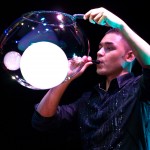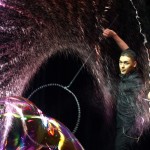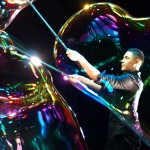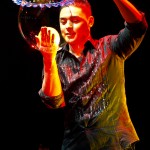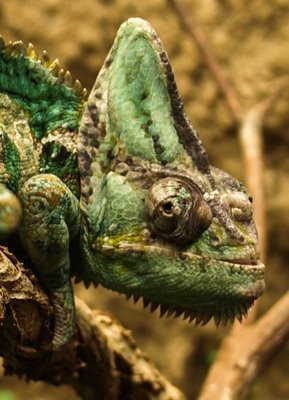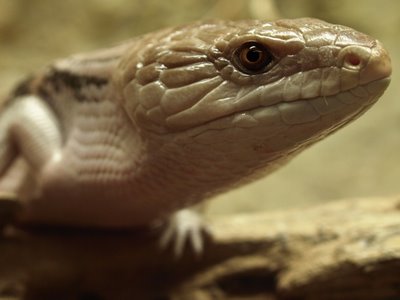I had an unexpected kid-free day today, so I took the chance to return to the Science Centre for the second day in a row to see the Body Worlds 2 special exhibit.
I set out early in order to try and beat the crowds, but need not have bothered, since by the number of cars parked in the parking lot that there were clearly more people than usual already at the OSC.
I didn’t want to bring the girls along, as I figured that they would be freaked out by all the bones, body parts and whole body plastinates. In the end I was a bit freaked out by it all, though largely in a good way. Despite my reticence at bringing my kids, the same thoughts didn’t seem to stop other parents.
As a member I got a discount to the exhibition, so I only had to pay about $14 or so to get in. I got my timed ticket for the 11:30 entrance, picked up an audio tour stick, and made my way into the exhibit hall.
The show begins the moment you step into what is normally the long upper entrance tunnel to the OSC. I noted with some amusement the black drapery hung over the sides, presumably so that people on the lower section cannot possibly see what’s on display upstairs, and to prevent anybody from dropping something like a ticket to someone waiting below. No cameras allowed.
The initial exhibits are bones: arms, legs and spine. The first hint of something out of the ordinary was the plastinated knee joint, displaying tendons and the patella clearly. Not just a bunch of dry bones. Then the first full-body plastinate, basically a skeleton arranged to look as if he was about to shake your hand. I noted how on the stand von Hagens had left his signature, affixing his stamp (of creation? artwork? authenticity?) on the display. This was the first of the unsettling elements for me about the show.
Near the end of the hallway were other more obvious plastinates of internal organs, starting with the brain. What struck me was how small it is, and couldn’t help but think that some shrinkage was involved, until I saw the example still situated within the skull. There were slices of brain depicting the swirls of white matter structure, and the unfortunate brains that had been afflicted with forms of cancer, the black melanoma lesions particularly striking in one example, the large black blobs obviously not supposed to be where they were.
The process through the hallway was slow, the number of people easily that of other popular exhibitions I’ve been to, like the start of the Feathered Dinosaurs exhibition at the ROM, or even the Tutankhamen exhibit from many years ago. I found the audio tour disappointing, mainly because I was hoping for more information on the nature of the plastinates than on just the anatomy, of which I remembered more than I thought. Given the waits between seeing individual exhibits due to crowds, I could often key in the number for an exhibit well before reaching. (Minor quibble — for that reason it would have been a better idea if the presenter had placed the audio tour number at the top of an exhibit instead of at it base.
At the end of the entrance hall are the first truly impressive posed full-body plastinates. The first shows the nervous system set against skeletal structures. Then there’s the iconic “Thinker” whose most interesting aspect are all of the exposed nerves running down his back. In between the two were more display cases containing internal organs. Most memorable were those of a normal pink lung set against the darkly stained lung of a smoker, set against the entirely black and shriveled lungs of a coal miner, looking solid from coal dust. I’ve never been a smoker but if I was seeing these would give me pause if I were. This of course, is the intention, but the direct comparison along a continuum was new to me. Other smoker’s lungs would be highlighted wherever they appeared throughout the exhibit.
The other full body plastinates at this point featured a skeleton walking just behind all of his musculature, one pace in front of him. Then the upside-down pole-vaulter whose viscera is displayed in a similar upside-down position, offering a novel view of the stomach and intestines. Then there’s the skier in the middle of a jump, cut down the middle to display his innards, followed by the iconic skateboarder as seen on subway posters I’ve seen who is depicted in the middle of a flip, held off only by his hand. By this point I was beginning to be interested in how these plastinates were mounted, and was impressed by what I could only assume to be metal rods running through the skateboarder’s hands that prevented from tumbling off the podium to the floor below. Again, this is not the sort of information that is readily supplied at any point — nothing on the mechanics of it all.
At this point I descended down the staircase into the atrium, where the crowd could at least spread around a little bit, and I felt less like cattle being herded about. The most striking thing from a distance is the adult camel, whose neck has been bisected into three parts. One looks like its feeding on the group, the second is in the middle, the third is looking forward. It’s no wonder why some people think initially it is three camels instead of one.
At the base of the stairs are some other animals (deer and gorilla) as examples of comparative anatomy. There are also some striking examples of only the circulatory system for a duck, rabbit and a human head, all suspended in a cube containing some clear liquid. All fascinating, but sans captions, which was frustrating. They were just there, floating in their cubes without context.
There are other posed plastinates, in largely athletic poses, such as the one of the man about to throw a javelin, or the male/female pair of ice skaters. There’s not a small dose of macabre humour thrown in, such as with the “drawer man”, who is opened up like a set of drawers, his left hand opening his chest wall to show you his heart.
There are a total of three female plastinates in the exhibit. There was one that haunted me: an obviously young woman who had been several months pregnant. The baby was exposed in the womb, and through a mirror you could see a darkened smoker’s lung exposed. An obvious tragedy for some family, stripped of identity and context. I guess for me what was missing from this exhibit in particular was identity – I realize that these were people, and am curious as to how they got to be here. In short, what happened? I realize that this is all done supposedly in the name of science, but the lack of context (both specific and the personal), the signatures which come across as hubris, and the sometime sacrifice of science to spectacle.
On my way out I bought a copy of the catalogue. The other thing I found disturbing was how much of a money-maker this seems to be: my usual OSC discount didn’t apply to any of the items on sale in support of the exhibition. Again, I can understand the reasoning for it -– it must help to pay for transportation costs, the not inconsiderable expense of making the plastinates -– but I would have preferred that von Hagens had been up front about it.
An unforgettable exhibit. I think once was enough though.
